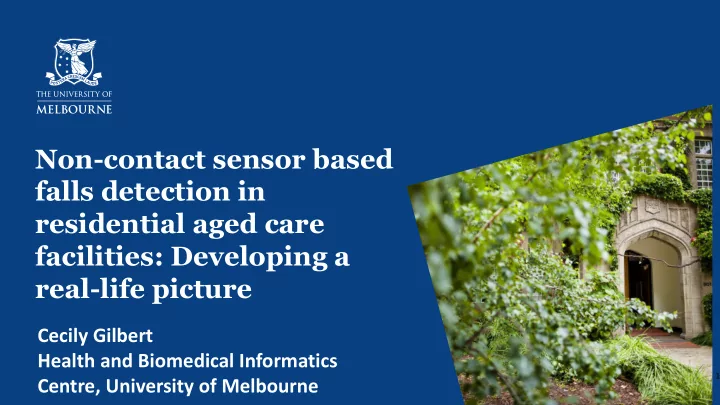

Non-contact sensor based falls detection in residential aged care facilities: Developing a real-life picture Cecily Gilbert Health and Biomedical Informatics 1 Centre, University of Melbourne
Falls facts in Australia More frequent for those aged 65+: - 30% of people living at home will have a fall each year. - much higher rate in aged care facilities. - leading reason for admission to hospital: 38% compared to 13% for transport related injuries. 2
Study Aim and method Objective: to test the feasibility and acceptability of a ambient non-wearable sensor technology with older participants in a residential care facility. Mixed method approach comprising: a) Empiric study implemented at a residential care facility using purposive sampling b) Evaluation and post-study interviews c) Analysis and review of results 3
Study setting and criteria Purpose-built aged care facility : Participant selection criteria : • 170 places, 200 staff • Aged 65+ • • Less than 8 years old Previous falls history (e.g. two or more in past 6 months) • Bed-exit and pressure mat alarms wired • Able to walk either independently or with to nurse-call system staff assistance (+/- gait aid) • IT support outsourced Exclusion criteria : Involvement in study : • Bed bound, or require hoist for transfers • Management & senior staff supportive • Residents currently receiving palliative • Agreed to screen occupants and approach care eligible residents (or authorised family • Residents who have had no falls in members) for consent to participate 4 previous 12 months
4 male residents in the pilot study - average age 87 years - complex chronic diagnoses Assessment Resident 1 Resident 2 Resident 3 Resident 4 Fall risk assessment HIGH HIGH HIGH HIGH Previous falls? No history available 5 falls in prior 6 13 falls in prior 6 1 fall in prior 6 months months months Uses gait aid? 4-wheel walker 4-wheel walker Wheelchair beyond 4-wheel walker room Mobility Assist X 1 Assist X 1 Transfer to Supervision X 1 assistance? wheelchair assist X 2 Level of care High Care High Care High Care High Care 5
Sensor installation In each participant’s suite: - one sensor in bedroom - another sensor in en-suite bathroom. Rolled out sequentially: - set up, test with healthy volunteer, live-test, then moved to next suite. - 8 sensors installed in total. 6
Depth images Prototype sensor adapted by industry partner • Privacy preserving • Optical, non-contact • On-board cognitive processing • Skeletal pose tracking • Suited to indoor environment • Designed for 24/7 operation
Results ITEM DATA Sensors functioning 8 installed, only 7 operated reliably Total days of sensor operation 122 Monitoring duration Range 5 – 22 days per participant Data generated 18 GB – 25 GB per day per room, saved as high compression files onto secure dedicated server Fall events One known fall occurred, but was not captured because sensor cable was faulty at the time. 8
Challenges and unexpected events Gaps in network connectivity e.g. not all room data points were cabled to the core network. Wireless workaround devised, not optimal. Radio-frequency interference from wall-mounted TV screens in bedroom disabled sensor wireless network: Sensors were re- positioned, but this caused tracking performance to decline, increased ‘noise’. As a result, the event detection threshold setting was raised to detect only medium or high fall-like events. Range and quality of the commercial pose-tracking component in the sensors was more limited in practice than shown in the lab testing: i.e. pose-tracking healthy volunteers was not adequate to determine sensor effectiveness with older person. 9
Acceptability Post-study interviews with staff indicated strong acceptance: Interview Question Response Did the sensors change the amount or type of No, it really didn’t have any negative impacts contact between residents and staff? on anybody. Do you have any concerns with the display of It’s not a facial picture – just stick figures visual images from the sensors? really. So that’s good for privacy and confidentiality. How is the sensor data useful for residents with I think it would be useful in [the RAC] overall, cognitive disabilities? for people who can’t articulate how a fall happened. Has being part of the sensor trial changed your It’s exciting where the research is taking view about sensors for fall detection or us…ultimately we want to keep our people prediction? safe. 10
Conclusions – Operational lessons learned Unexpected technical difficulties delayed full implementation of sensors in participants’ rooms - End-to-end live testing of hardware and networks is essential before launching. Optimal placement of sensors is not straightforward - Suggests need to involve clinicians in realistic calibration for sensors to balance sensitivity and specificity . Staff and carer attitudes to the sensors were positive overall i.e. envisaged a range of benefits if proven to work: knowing the events that lead to a fall, earlier detection of falls if sensors are linked to alarm system etc. 11
Acknowledgements and team members Study team: Thanks to: • A/Prof Ann Borda 1 • Study participants and their carers • Dr Cathy Said 2 • • Mr Frank Smolenaers 3 Staff at the residential facility • Mr Michael McGrath 4 • Study Advisory Board members. • A/Prof Kathleen Gray 1 • Ms Cecily Gilbert 1 Funding gratefully received from the (1) Health and Biomedical Informatics Centre, Melbourne Networked Society University of Melbourne (2) Physiotherapy Directorate, Western Health Institute. (3) Australian Centre for Health Innovation, Alfred Health (4) Semantrix Pty Ltd 12
Thank you cecilyg@unimelb.edu.au
Recommend
More recommend